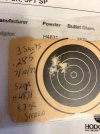Way back in the dark ages, there wasn't a lot of factory 25-06 brass available. In one of the shooting magazines, I found an article that using an RCBS 25-06 trim die you could "neck down" 30-06 brass successfully. Then after trimming to length with a fine file, chamfering the case mouths, and then running them back through full-length sizing dies you could produce brass was totally acceptable. The article did recommend fire forming the brass with low-pressure loads then working up to the desired velocity. I was able to procure a good quantity of Lake City military brass at a gun show for a reasonable price. The article also recommended annealing the necks, which was a chore using a butane torch and templaq marking. I used that brass for years before finally retiring them. My go-to load was 52 grains of H4831. It's still the load I use on that rifle.


